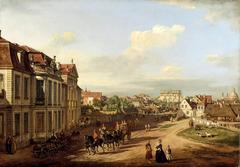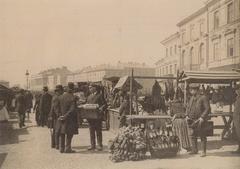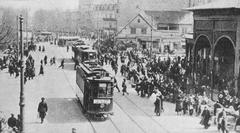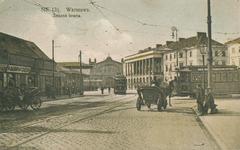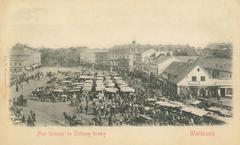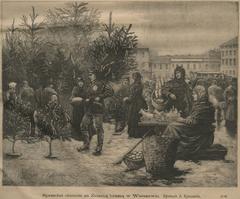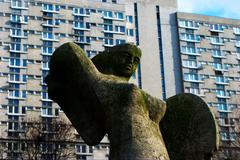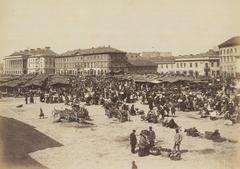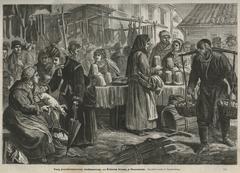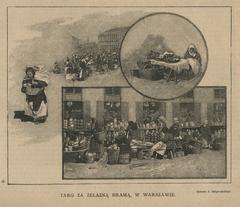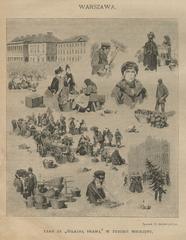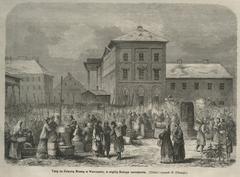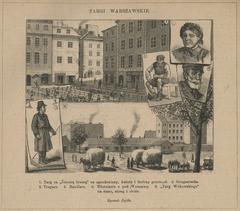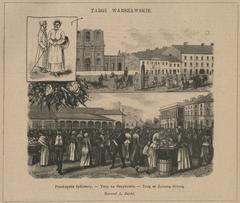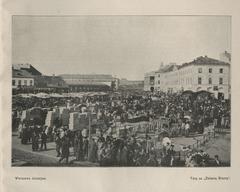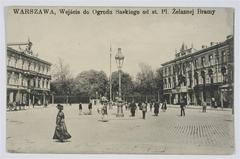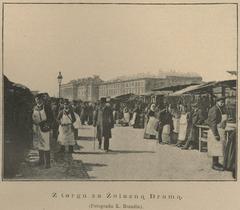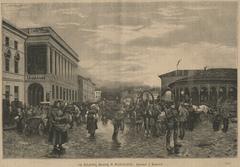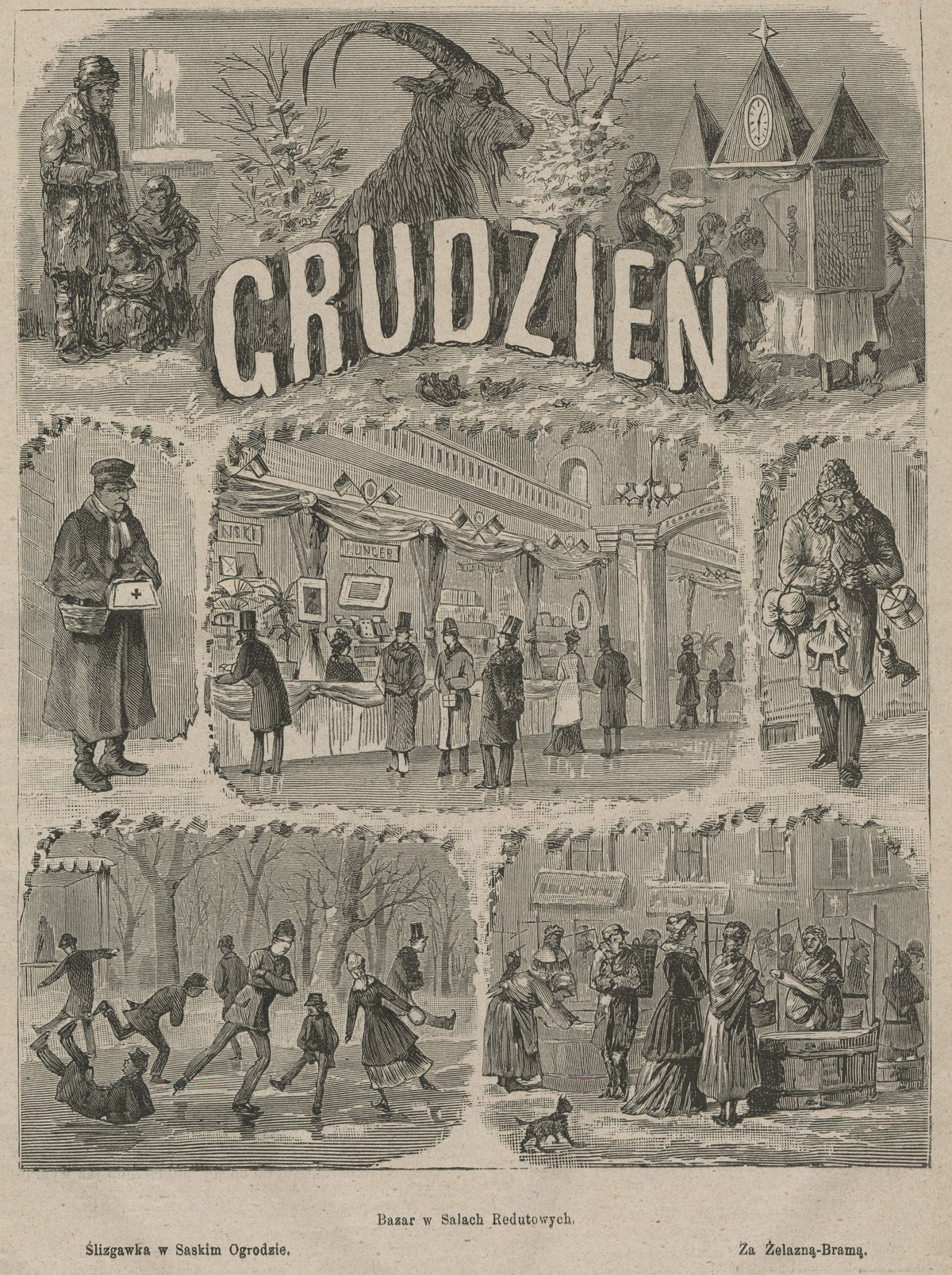
Iron-Gate Square Visiting Guide: Warsaw, Poland – Tickets, Hours, and Tips
Date: 15/06/2025
Introduction: Iron-Gate Square’s History and Significance
Iron-Gate Square (Plac Żelaznej Bramy) sits at the heart of Warsaw’s Śródmieście district, serving as a living testament to the city’s layered history and resilient spirit. Its name commemorates the grand Iron Gate, once the majestic western entrance to the Saxon Garden—an emblem of Baroque urban planning and royal prestige under King Augustus II the Strong in the early 18th century. Though the original gate was dismantled and eventually lost during wartime, its legacy persists through the square’s name, the local architectural landscape, and the enduring influence of the Saxon Axis, a visionary urban alignment that has shaped Warsaw for centuries (Wikipedia; whitemad.pl).
Today, Iron-Gate Square is both a gateway to Warsaw’s royal past and a vibrant urban nexus, surrounded by historic landmarks such as the Lubomirski Palace, the Tadeusz Kościuszko Monument, and the lush Saxon Garden. The square is open to all, offering a blend of architectural marvels, cultural memory, and accessible public space, making it an essential destination for visitors eager to engage with Warsaw’s rich heritage (audiala.com; findingpoland.com; warsawtour.pl).
Contents
- Introduction
- Historical Overview
- Origins and Early Development
- The Saxon Axis and the Iron Gate
- 19th-Century Commercial Hub
- World War II Impact and Postwar Reconstruction
- Architectural Features and Symbolism
- Visitor Information
- Hours, Tickets, and Accessibility
- Guided Tours and Special Events
- Key Landmarks and Nearby Attractions
- Cultural Memory and Contemporary Significance
- Frequently Asked Questions (FAQ)
- Visuals and Multimedia
- Explore More and Plan Your Visit
- Sources
Historical Overview
Origins and Early Development
The area now known as Iron-Gate Square traces its origins to the 17th century, when it was part of the Wielopole jurydyka, a private town founded by the widow of Jan Wielopolski. Centered around a bustling market square—likely designed by Tylman van Gameren—it soon attracted prominent noble families, including the Lubomirski and Radziwiłł dynasties, whose palaces lent prestige to the district (Wikipedia).
The Saxon Axis and the Iron Gate
In the early 18th century, King Augustus II the Strong initiated the Saxon Axis, a grand Baroque urban plan aligning Warsaw’s major landmarks along a ceremonial route. The Iron Gate, constructed between 1735 and 1738, marked the western entrance to the Saxon Garden and stood as an ornate symbol of royal power and architectural ambition. Its massive stone pylons, wrought-iron grille, and gilded embellishments epitomized the era’s grandeur (whitemad.pl).
19th-Century Commercial Hub
Throughout the 19th century, Iron-Gate Square flourished as a center of commerce and social life. Notable developments included the construction of the Gościnny Dwór market hall and the rise of surrounding tenement houses. The Lubomirski Palace, with its Rococo and neoclassical features, remained a landmark of aristocratic Warsaw.
World War II Impact and Postwar Reconstruction
The devastation of World War II, particularly during the 1944 Warsaw Uprising, left Iron-Gate Square and its surroundings in ruins. The Iron Gate itself was lost, and much of the area’s historic architecture was destroyed. Postwar redevelopment brought modern residential blocks and significant urban changes, most notably the rotation and restoration of the Lubomirski Palace to realign with the original Saxon Axis (Reddit).
Architectural Features and Symbolism
The original Iron Gate combined robust stone pylons with intricate wrought-iron work, featuring royal insignia, coats of arms, and ornamental crowns. Its design represented the aspirations of an Enlightenment-era Warsaw, linking the city to prevailing European trends of symmetry, axiality, and ceremonial grandeur. Even after its removal in the 19th century, the gate’s memory influenced the identity of the surrounding district, including the Za Żelazną Bramą (Behind the Iron Gate) housing estate (whitemad.pl).
Visitor Information: Hours, Tickets, and Accessibility
- Visiting Hours: Iron-Gate Square is open 24/7. The adjacent Saxon Garden generally welcomes visitors from 6:00 AM to dusk.
- Tickets: No admission fees are required for Iron-Gate Square or the Saxon Garden. Some nearby sites, like special exhibitions at the Lubomirski Palace, may charge an entry fee.
- Accessibility: The square features paved walkways suitable for wheelchairs and strollers, with curb cuts and accessible paths. Public transportation—trams, buses, and the Ratusz Arsenał metro station—serves the area, and limited parking is available nearby.
- Guided Tours and Events: Walking tours featuring Iron-Gate Square, the Saxon Axis, and the Lubomirski Palace are offered by local agencies. The square also hosts seasonal markets and cultural events (warsawtour.pl).
Key Landmarks and Nearby Attractions
- Lubomirski Palace: This 18th-century Baroque landmark was famously rotated in 1970 to align with the Saxon Axis. It now houses cultural institutions and occasionally offers public exhibitions (findingpoland.com).
- Tadeusz Kościuszko Monument: Erected in 2010, this bronze statue honors the national hero and marks the historical site of the original Iron Gate (audiala.com).
- Saxon Garden (Ogród Saski): One of Europe’s oldest public parks, featuring Baroque sculptures, fountains, and shaded avenues (findingpoland.com).
- Mirowskie Halls (Hale Mirowskie): Historic 19th-century market halls still bustling with local life.
- Za Żelazną Bramą Housing Estate: A postwar residential complex named in homage to the Iron Gate, reflecting Warsaw’s communist-era urbanism.
Cultural Memory and Contemporary Significance
Iron-Gate Square symbolizes Warsaw’s journey from royal grandeur, through wartime destruction, to modern resurgence. While the original gate no longer stands, its spirit endures in the square’s name, the alignment of urban landmarks, and the ongoing use of the space for public gatherings and cultural events. The integration of architectural heritage and contemporary public life makes the square a living chronicle of Warsaw’s resilience.
Frequently Asked Questions (FAQ)
Q: Are there entrance fees for Iron-Gate Square or the Saxon Garden?
A: No, both are free and open to the public.
Q: What are the best times to visit?
A: Daytime visits are ideal for enjoying the gardens, nearby markets, and architectural landmarks. Spring and summer offer lush greenery and vibrant events.
Q: Is the area wheelchair accessible?
A: Yes, paved paths and accessible infrastructure make the square suitable for visitors with mobility needs.
Q: Are guided tours available?
A: Yes, many walking tours include Iron-Gate Square, the Saxon Axis, and nearby historic sites.
Q: How do I get there by public transport?
A: The square is served by multiple tram and bus lines, with the Ratusz Arsenał metro station a short walk away.
Q: Are there restrooms nearby?
A: Public restrooms are available in the Saxon Garden and nearby commercial venues.
Visuals and Multimedia Recommendations
- Images: High-resolution photographs of Iron-Gate Square, the Tadeusz Kościuszko Monument, Lubomirski Palace, and the Saxon Garden.
Alt text example: “Tadeusz Kościuszko Monument at Iron-Gate Square, Warsaw.” - Interactive Map: Pinpointing Iron-Gate Square and surrounding attractions.
- Virtual Tours: Some official tourism sites offer 3D reconstructions or virtual walks of the Saxon Axis and gardens.
Explore More
For a deeper dive into Warsaw’s historical sites, download the Audiala app for audio guides, interactive maps, and real-time updates on tours and events.
Conclusion & Call to Action
Iron-Gate Square is much more than a city plaza—it is a vibrant intersection of Warsaw’s royal legacy, architectural heritage, and contemporary life. From the symbolic echoes of the Iron Gate and Baroque splendor of the Lubomirski Palace to the tranquil avenues of the Saxon Garden, the square invites visitors to immerse themselves in the story of a city that has reinvented itself time and again.
To make the most of your experience, plan your visit using the Audiala app, which offers curated guides, walking tour bookings, and insider travel tips. Discover the many layers of Warsaw’s past and present, and let Iron-Gate Square be a highlight of your journey through Poland’s capital.
Sources
- Wikipedia - Plac Żelaznej Bramy
- Warszawska.info - History of Plac Żelaznej Bramy
- Official Warsaw Tourism Website
- WhiteMAD – Za Żelazną Bramą Housing Estate
- Audiala - Tadeusz Kościuszko Monument
- FindingPoland - Saxon Garden
- Reddit - Old Photos in Real Life: Iron Gate Square

